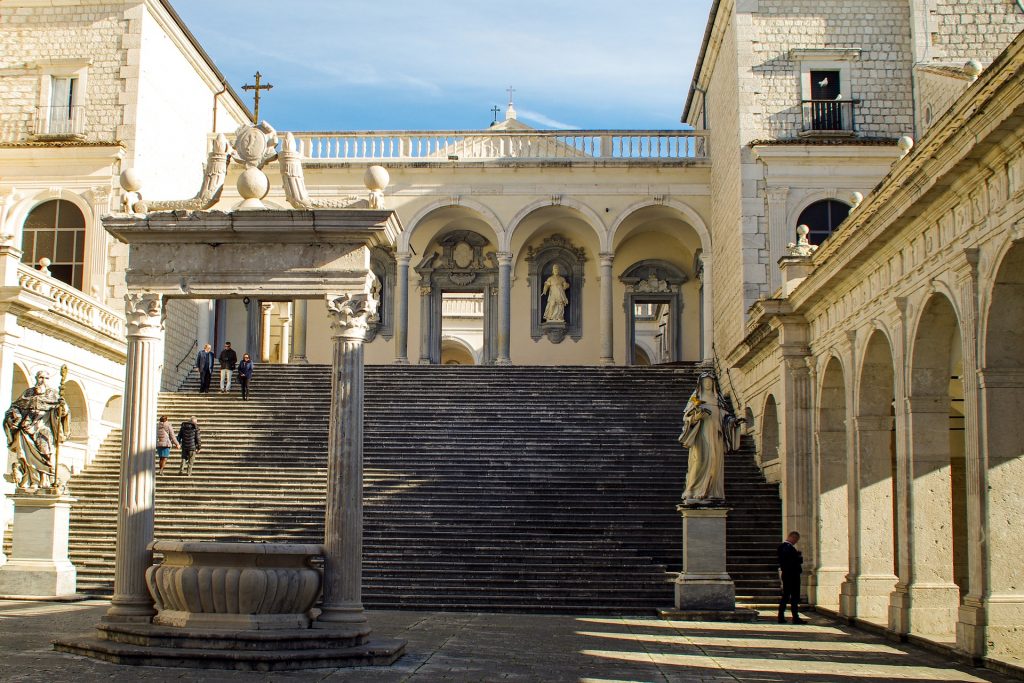Every summer, to reach Puglia, I travelled along the Adriatic highway. Last year I decided to go there again but to change the route.
This is what is sometimes done even in life, and allows us to discover new people, things, places, sensations.
So I decided to go to Puglia along the Autosole giving me as a stop to break the long journey, Montecassino.
I am a fan of World War II and I had recently read a book set in those places, a theatre of war with the culmination of the bombing of the Benedictine abbey.
I wanted to see the places where the Gustav Line passed.
Arriving in Montecassino on a sunny July afternoon I was enchanted by the places known in the history books, so beautiful, green with gentle slopes and neat rows of vineyards and orchards.
The Abbey of Montecassino, although rebuilt, was majestic and serene, and the countryside around it so green and lushl with many war cemeteries in its heart.
I visited the abbey which I still remember and which I recommend to visit for its mysticism and for the memory of the history of our country.
After the visit, I had planned to stop in a not too distant town, Picinisco.
My choice had been dictated by learning that there was a popular spread hotel where you could sleep.
And so through another unknown piece of our country, between vineyards and cornfields and hilly slopes, I arrived at Picinisco towards sunset.
A real surprise!
This ancient village of about 1,000 inhabitants in the province of Frosinone lies between the Lazio border with Abruzzo and Molise and is 700 meters high in the Comino Valley within the Abbruzzo National Park, Lazio and Molise.
It was an enchantment that made me feel back in time.

Upon arrival I was greeted by the owners of the hotel spread across several buildings: a couple of nice and kind lawyers from Edinburgh, whose great-grandparents had gone to Scotland in the early 1900s to make their fortune.
To access the hotel you need to pass through a gate called of the Clocks, noting that the village grew inside the walls set up to defend the castle, of which it retains the characteristics of the fortified medieval structure.
From this Porta degli Orologio, you take Via Maggiore where there are some noble palaces of interest and from there, alleys branch off with houses and squares in an explosion of colours thanks to balconies with flowering gardens.
Perfumes of falling geraniums, daisies, roses, hydrangeas, say the old and distinguished ladies who water them in the evening.
It is a poem. No cars and a muffled chatter between one balcony and another.
I found myself in a world that I thought was lost, peace, noble beauty and the care of the lanes and flowers.

Returning to the hotel with a view of the valley below of olive trees and vineyards, to an aperitif with the owner of the hotel on the ancient square under the arch overlooking the vast plain and the Mainarde mountain group,.
Virtually everyone knew each other and everyone spoke in English, children, the elderly, young people.
And yes, because as my patron John explained to me, we have in summer in Picinisco all the English and Scottish grandchildren and children of the Italian Piciniscos who had emigrated en masse in the 1900s to the lands of Albione.
And then in that square with that view, under a plane tree to drink the spritz, John tells me a bit of history. This land of conquest by the Samnites and then of the Romans. Then Normans, Swabians, Angevins, Aragonese, French, Spanish and then with the Bourbons and finally the arrival of the bandits.
But it was just about time for dinner and so I ventured for some Lazio street-food in a delightful almost mountain chalet where those who love fossa cheeses have a field day. I got 2 types of aged pecorino. And then bread and pasta made by the elderly ladies. Another world.
Peace, tranquillity, beauty, history, a certain I don't know what. This was Picinisco for me.
Then in the morning I headed towards Puglia without first stopping in the ancient hamlet the Ciacca of his grandparents that the lawyer John restored and where he made a magnificent cellar of advanced wine production in Maturano (LINK) thus saving an autochthonous vine that otherwise would have died out.
This is the so-called Italia Minore!
Places aromatic flavours that bring us back to a forgotten arcadia that yet exists.
If you can visit these places!







Follow us